Instrumentation Switches in Automation: Pressure, Level, Flow, and Temperature Explained
Published on Jun28, 2024 | Category: introductionShare this Page:
A switch is an essential device used in automation systems to control the flow of electrical current by either opening or closing a circuit. In this article, we will explore what switches are, how they function in instrumentation, and the different types commonly used in industrial automation.
At its core, a switch operates on a simple mechanism: ON (closed) or OFF (open). When turned ON, current flows through the circuit; when OFF, the current stops. This binary functionality makes switches perfect for digital control applications, especially in PLC-based systems.
In industrial automation, the same principle is applied. For example, a pressure switch may be designed to change its state when a specific pressure is reached. Suppose a switch is normally closed (NC) and opens (NO) at 5 bar—once this pressure threshold is reached, it breaks the contact, signaling a fault or initiating another control action.
Connecting Switches to PLCs:
Switches have two states—ON and OFF—which correspond to digital signals. These are connected to the PLC’s digital input module. The PLC reads the ON/OFF status and executes logic accordingly.
Example:
A pressure switch is set to open its contact when pressure exceeds 6 bar. This switch is connected to a PLC input. When pressure crosses the limit, the switch opens, the signal to the PLC changes from HIGH to LOW (or vice versa), and the PLC may trigger an alarm, shut down a compressor, or log the event.
In summary, switches are fundamental in automation systems. They serve as the first line of detection in many control loops and are simple yet powerful tools for maintaining system safety and efficiency. Understanding switch types and their integration with PLCs is crucial for every instrumentation or automation engineer.
What is a Switch?
A switch is an electrical or electronic device used to control the flow of current in a circuit by opening (OFF) or closing (ON) the electrical path. It acts as a control point for turning devices or systems ON and OFF. In automation systems, switches help in monitoring and controlling various processes by providing binary (0/1) inputs to the controller or PLC.
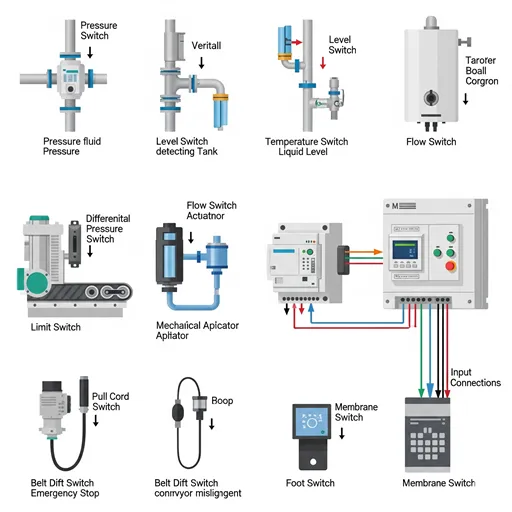
Basic Working Principle of Switches
The fundamental working principle of a switch is based on the interruption or completion of an electrical circuit. When the switch is ON (closed), current flows through the circuit. When it is OFF (open), the circuit is broken, and the flow of current stops.
This simple ON/OFF action forms the basis of control in digital systems, making switches essential components in industrial automation, electrical panels, and instrumentation systems.
What is the Role of Switches in Instrumentation?
In instrumentation, switches are used to monitor physical parameters (like pressure, temperature, level, or flow) and generate digital signals (ON/OFF) based on threshold values. These signals are then used by PLCs or control systems to trigger alarms, start/stop equipment, or change process conditions.
Key roles include:
- Providing digital inputs to controllers
- Ensuring safety by acting as interlocks
- Initiating or terminating control actions based on conditions
- Supporting alarms and shutdown systems
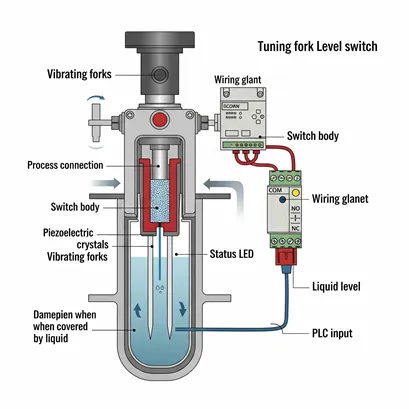
Types of Switches in Instrumentation
There are several types of switches used in instrumentation, depending on the physical quantity being monitored. Common types include:
- Pressure Switch: Activates when a certain pressure is reached; commonly used in pneumatic and hydraulic systems.
- Level Switch: Detects the level of liquids or solids in tanks or silos (e.g., float switch, capacitive level switch).
- Temperature Switch: Operates when a specified temperature is reached; used in heating or cooling systems.
- Flow Switch: Monitors the presence or absence of flow in pipelines; used in pump and fluid systems.
- Differential Pressure Switch: Senses the pressure difference between two points, typically used in filters or duct systems.
What is Pressure Switch?
Working Principle with Example: A pressure switch operates by detecting fluid or gas pressure in a system. It changes state (opens or closes contact) when the pressure reaches a preset threshold. Internally, it uses a diaphragm, piston, or bourdon tube that deflects with pressure and triggers the switch mechanism.
Example: In an air compressor, a pressure switch turns off the motor when pressure exceeds the set limit (e.g., 8 bar) and turns it back on when pressure drops below 6 bar.
Application: Used in hydraulic and pneumatic systems, water pumps, boilers, HVAC systems, and compressors.
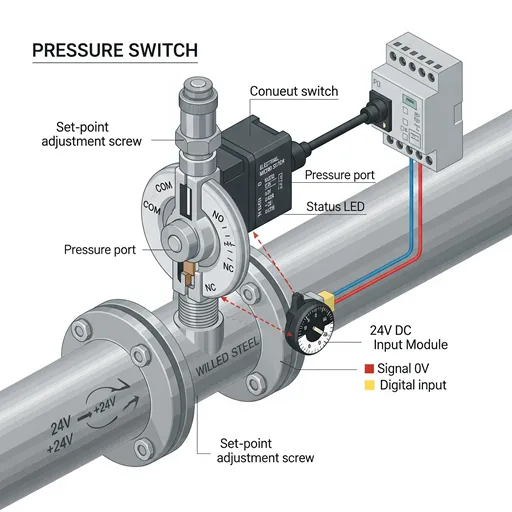
What is Level Switch?
Working Principle with Example: A level switch detects the level of liquids or solids in a tank. It can use float, capacitive, ultrasonic, or vibrating fork technology to sense presence or absence of material.
Example: A float-type level switch in a water tank triggers a pump when the level goes below a set point, and stops it when the tank is full.
Application: Water treatment plants, chemical tanks, overhead and underground storage tanks, and sump pumps.
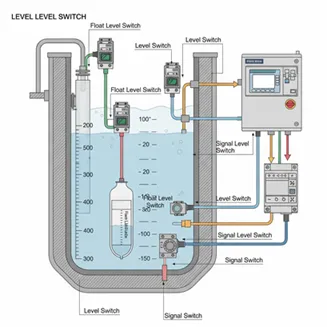
What is Temperature Switch?
Working Principle with Example: A temperature switch senses temperature using a bimetallic strip, thermocouple, or RTD. When the measured temperature exceeds or falls below the setpoint, it changes contact position.
Example: In a heating system, a temperature switch turns off the heater when the temperature exceeds 80°C to avoid overheating.
Application: Used in HVAC systems, boilers, heat exchangers, and engines.
What is Flow Switch?
Working Principle with Example: A flow switch detects whether fluid is moving through a pipe. It typically uses a paddle, turbine, or thermal sensor that reacts when flow reaches a specific rate.
Example: In a cooling system, a flow switch stops the chiller if coolant flow is lost, preventing equipment damage.
Application: Chillers, HVAC cooling loops, chemical dosing systems, and pump protection circuits.
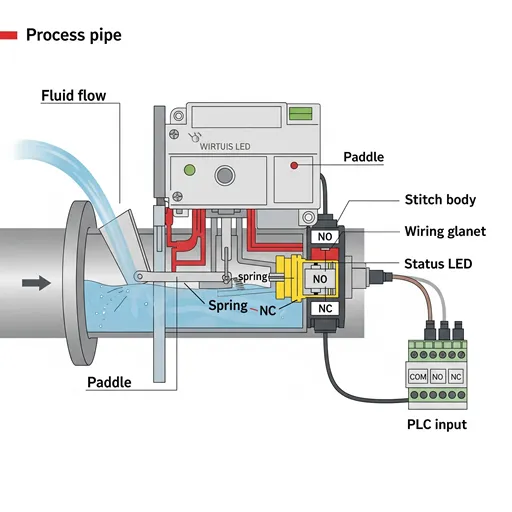
What is Differential Pressure Switch?
Working Principle with Example: This switch monitors the pressure difference between two points. When the differential exceeds a set limit, it actuates a switch using a diaphragm or bellows mechanism.
Example: In an air filter system, when the pressure drop across the filter exceeds the limit, a DP switch triggers a maintenance alert.
Application: Air filtration units, duct systems, flow monitoring, and clean room ventilation.
What is Proximity Switch?
Working Principle with Example: A proximity switch detects the presence of an object without physical contact, using electromagnetic (inductive), capacitive, ultrasonic, or optical sensing.
Example: An inductive proximity sensor in an assembly line detects metal parts as they pass by and signals the PLC to count or sort them.
Application: Conveyor automation, object detection, safety interlocks, and machine feedback.
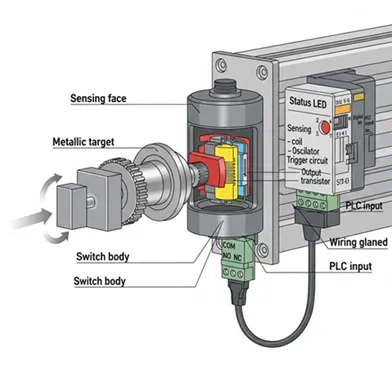
What is Pull Cord Switch?
Working Principle with Example: A pull cord switch (also called rope switch) is a safety switch installed along conveyor belts. When the cord is pulled from any point, it breaks the circuit and stops the conveyor system.
Example: If a worker notices an emergency on a conveyor, pulling the rope anywhere along the line stops the system immediately.
Application: Conveyor systems in mining, cement, and material handling industries for emergency shutdown.
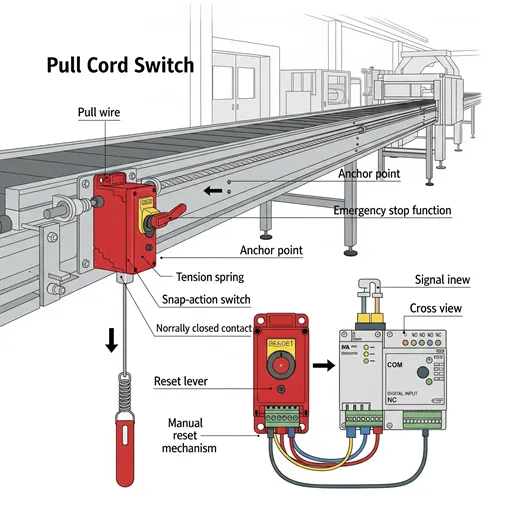
What is Belt Drift Switch?
Working Principle with Example: A belt drift switch monitors the alignment of a conveyor belt. If the belt drifts beyond the safe limit, it actuates a lever or roller arm, triggering the switch to alert or stop the motor.
Example: In a conveyor system, if the belt shifts to one side, the switch activates to prevent belt damage or spillage.
Application: Conveyor belt alignment monitoring in industries like coal handling, mining, packaging, and manufacturing plants.
What is a Limit Switch?
Working Principle with Example: A limit switch is a mechanical device that operates when a moving object comes into contact with an actuator (roller, lever, or plunger). It converts mechanical motion into an electrical signal (ON/OFF).
Example: In a CNC machine, a limit switch is placed at the end of the machine’s axis travel. When the machine reaches the end, it hits the switch, stopping further movement to prevent mechanical damage.
Application: Widely used in position detection, machine safety interlocks, elevator systems, conveyor end detection, and packaging machines.
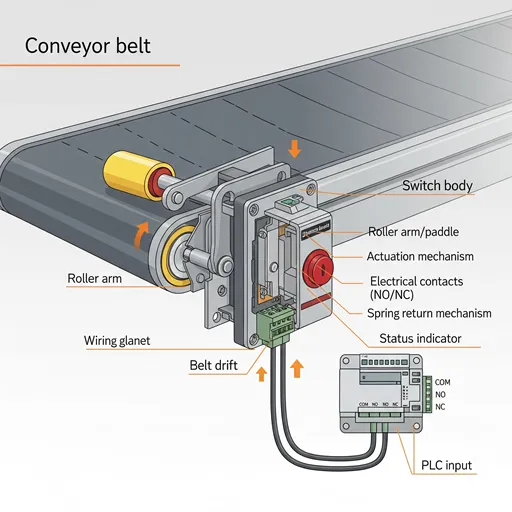
What is a Foot Switch?
Working Principle with Example: A foot switch is a type of manually operated switch that is actuated by foot pressure. It frees the hands for other operations and is often used in environments where both hands are occupied.
Example: In an industrial press machine, a foot switch allows the operator to initiate the pressing cycle using their foot while keeping their hands on the material.
Application: Medical equipment (dental chairs), industrial presses, sewing machines, and automation systems requiring hands-free control.
What is a Membrane Switch?
Working Principle with Example: A membrane switch is a touch-sensitive, low-profile switch that uses pressure to close an electrical circuit. It consists of multiple flexible layers and conductive traces, usually printed on polyester or polycarbonate film.
Example: On a microwave oven, the control panel buttons are membrane switches that respond when pressed lightly to start cooking, set the timer, etc.
Application: Control panels in home appliances, medical instruments, handheld devices, touch interfaces, and compact embedded systems.